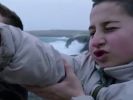Eye For Film >> Movies >> Fire At Sea (2015) Film Review

Gianfranco Rosi understands that the way to the audience's conscience is not through images of suffering crosscut with "expert" talking heads giving statistics. Fire At Sea (Fuocoammare) is a masterpiece not only of documentary filmmaking but of timely and abiding storytelling. The filmmaker/cinematographer is a master of light, bathing each image with meaning.
Whereas Sacro GRA was structured as a brilliant patchwork quilt of the people living around the Grande Raccordo Anulare of Rome, Rosi's latest film shows us Italy's southernmost island, Lampedusa, south of Sicily, in the Mediterranean Sea, where waves of migrants from Africa arrive in boats often under inhumane conditions. The death toll is rising and rising. News reports can have the effect of shocking and desensitising - the opposite is happening here. It's a confrontation with what we want to see and what we don't.

We are given different strands of narrative on the island - adolescent Samuele is a winning, completely natural combination of Bruno Dumont's Li'l Quinquin, a Wes Anderson boy scout in Moonrise Kingdom, and the scientist who recorded the sound of palm trees in Sacro GRA. "You gotta have passion," the boy insists.
The disarming Samuele takes us on his adventures. He teaches his friend as they roam the landscape, to make slingshots from pine tree branches and cut-up rubber gloves. He mimics the sound of machine gun fire. He also is able to communicate with a baby bird, and nobody eats pasta like Samuele.
Samuele is a creature of the land, who gets easily seasick - not a good sign on an island where everyone, including his father, is a fisherman or sailor. The boy has to work on his sea legs as well as his lazy eye, by wearing light green glasses with a pink eye-patch inlay. If following him seems more appealing than opening your eyes to the tragedies unfolding on the refugee boats nearby, this awareness is precisely the point. Both exist side by side.
The symbolism in Fire At Sea is so organic that it might dawn on you hours or days after seeing the film. What eye should we start to train? When metaphors aren't artificial, they take your breath away. Will the diver in the reefs find more than sea urchins?
The attentive and wise doctor on the island takes care of both locals and migrants, the radio DJ Pippo fulfills music wishes, widows take charge of the cooking and other household chores that do not seem to have changed much since the Second World War, when the waves around Lampedusa turned red one night and the sea caught fire.
The doctor links the two separate worlds of the humans of the island and the humans at sea. He examines a pregnant woman who survived the boat trip. She will have twins. In her belly, their legs are intertwined. "She suffered," he comments, "so the pregnancy suffered." But she will be fine, he predicts, unlike so many others who had to give birth on the crammed boats. Many passengers arrive drenched in diesel, with life-threatening chemical burns on their bodies.
The Second World War, time of the last refugee crisis to match ours right now, enters the picture unobtrusively from the sidelines. There is the story of the fire at sea, told by Samuele's grandmother while she is mending the hem of a white linen napkin, sitting by the window, triggered by thunder rumbling outside.
There is the framed black and white photograph of a man in uniform on the nightstand while a woman is making the bed in a bedroom that must not have changed much in half a century. A porcelain statue of the Virgin Mary watching over the sleep.
Audiences are coaxed to weave individual tapestries of reference. Nostalgia trapped in the objects of the island makes for a stark contrast to the starving, dehydrated refugees fighting for their lives. Wrapped in golden silver heat foil, we see how they are registered and have their photos taken. Where do the refugees come from? The question is answered effectively through an improvised soccer tournament in the migrant housing area, when we hear cheers for Somalia, Sudan, Syria or Eritrea, respectively.
The numbers on the opening title cards - 400,000 migrants - 15,000 people who have died - don't stay abstract for long. We see the sky, a searchlight, and hear the disembodied voices of a rescue mission. "Your position?" one voice asks repeatedly. "We beg you, please," another, desperate voice answers.
The island is beautiful and rough, a perfect setting for The Tempest. The images from the rescue operations conjure up a multitude of emotions and references - the boats and helicopters have a science fiction feel of an alien invasion. The searchlight looks like WALL-E, the robot, a boat resembles a steel helmet, the blue light of monitors cuts edges into what we see on the screen, a piece is missing from the moon while it is falling into the sea.
Suddenly, a romantic, crooning melody takes us away into the windowless realm of the local DJ and with the music, we travel into the kitchen of Aunt Maria, chopping tomatoes to make a sauce. The music is interrupted. Another boat with 250 people arrived. The DJ gives the number of the dead. "Poor souls," says Maria and continues cooking. On the radio, someone requests the song called My Little Donkey. It is followed by the island favourite "Fuocoammare", dedicated to all the fishermen out there. Never would I have imagined what it sounds like.
More and more, it dawns on us that these aren't separate stories at all. Time is standing still and races on. The neon green of the helicopter holding station and the milky watermelon-red of the sunrise belong to the same field of vision.
Reviewed on: 20 Sep 2016
















